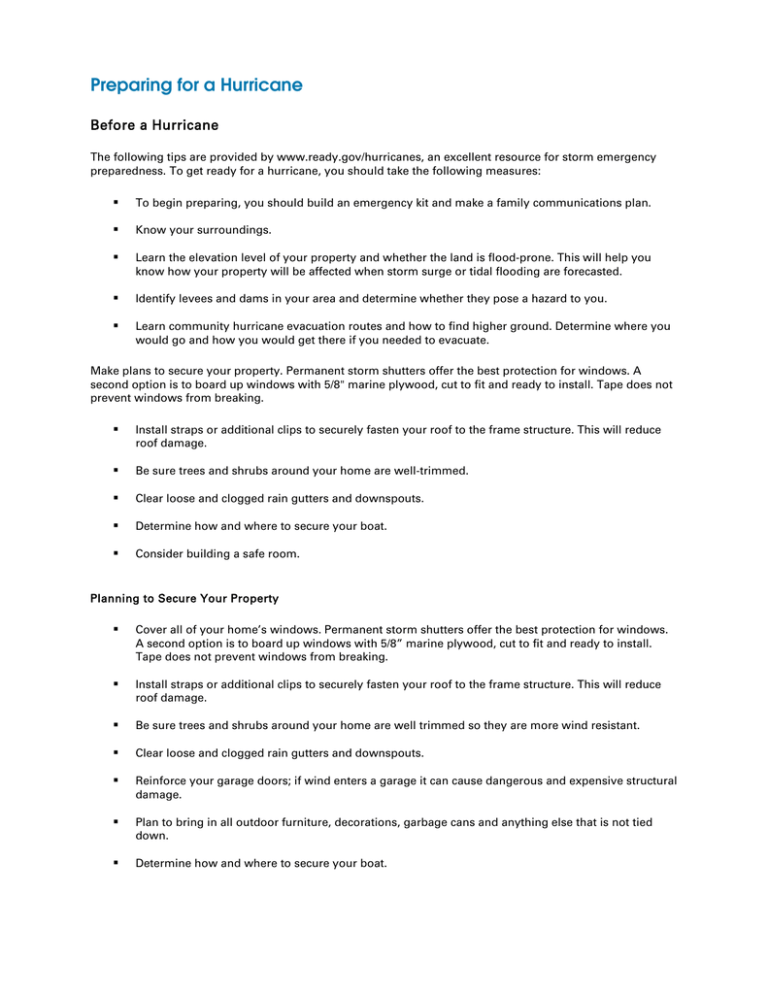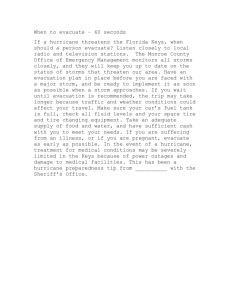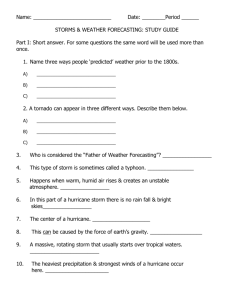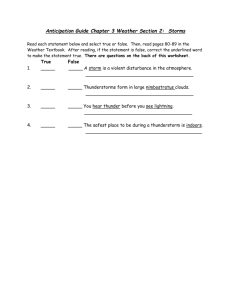Preparing for a Hurricane
advertisement

Preparing for a Hurricane Before a Hurricane The following tips are provided by www.ready.gov/hurricanes, an excellent resource for storm emergency preparedness. To get ready for a hurricane, you should take the following measures: To begin preparing, you should build an emergency kit and make a family communications plan. Know your surroundings. Learn the elevation level of your property and whether the land is flood-prone. This will help you know how your property will be affected when storm surge or tidal flooding are forecasted. Identify levees and dams in your area and determine whether they pose a hazard to you. Learn community hurricane evacuation routes and how to find higher ground. Determine where you would go and how you would get there if you needed to evacuate. Make plans to secure your property. Permanent storm shutters offer the best protection for windows. A second option is to board up windows with 5/8" marine plywood, cut to fit and ready to install. Tape does not prevent windows from breaking. Install straps or additional clips to securely fasten your roof to the frame structure. This will reduce roof damage. Be sure trees and shrubs around your home are well-trimmed. Clear loose and clogged rain gutters and downspouts. Determine how and where to secure your boat. Consider building a safe room. Planning to Secure Your Property Cover all of your home’s windows. Permanent storm shutters offer the best protection for windows. A second option is to board up windows with 5/8” marine plywood, cut to fit and ready to install. Tape does not prevent windows from breaking. Install straps or additional clips to securely fasten your roof to the frame structure. This will reduce roof damage. Be sure trees and shrubs around your home are well trimmed so they are more wind resistant. Clear loose and clogged rain gutters and downspouts. Reinforce your garage doors; if wind enters a garage it can cause dangerous and expensive structural damage. Plan to bring in all outdoor furniture, decorations, garbage cans and anything else that is not tied down. Determine how and where to secure your boat. Install a generator for emergencies. If in a high-rise building, be prepared to take shelter on or below the 10th floor. Consider building a safe room. During a Hurricane If a hurricane is likely in your area, you should: Listen to the radio or TV for information. Secure your home, close storm shutters, and secure outdoor objects or bring them indoors. Turn off utilities if instructed to do so. Otherwise, turn the refrigerator thermostat to its coldest setting and keep its doors closed. Turn off propane tanks. Avoid using the phone, except for serious emergencies. Moor your boat if time permits. Ensure a supply of water for sanitary purposes such as cleaning and flushing toilets. Fill the bathtub and other large containers with water. You should evacuate under the following conditions: If you are directed by local authorities to do so. Be sure to follow their instructions. If you live in a mobile home or temporary structure, such shelters are particularly hazardous during hurricanes no matter how well-fastened to the ground. If you live in a high-rise building. Hurricane winds are stronger at higher elevations. If you live on the coast, on a floodplain, near a river, or on an inland waterway. If you feel you are in danger. Learn more about evacuations at www.ready.gov/evacuating-yourself-and-your-family. If you are unable to evacuate, go to your safe room. If you do not have one, follow these guidelines: Stay indoors during the hurricane and away from windows and glass doors. Close all interior doors; secure and brace external doors. Keep curtains and blinds closed. Do not be fooled if there is a lull; it could be the eye of the storm. Winds will pick up again. Take refuge in a small interior room, closet, or hallway on the lowest level. Lie on the floor under a table or another sturdy object. Adapted from FEMA.gov and Ready.gov. Reviewed 08/12



